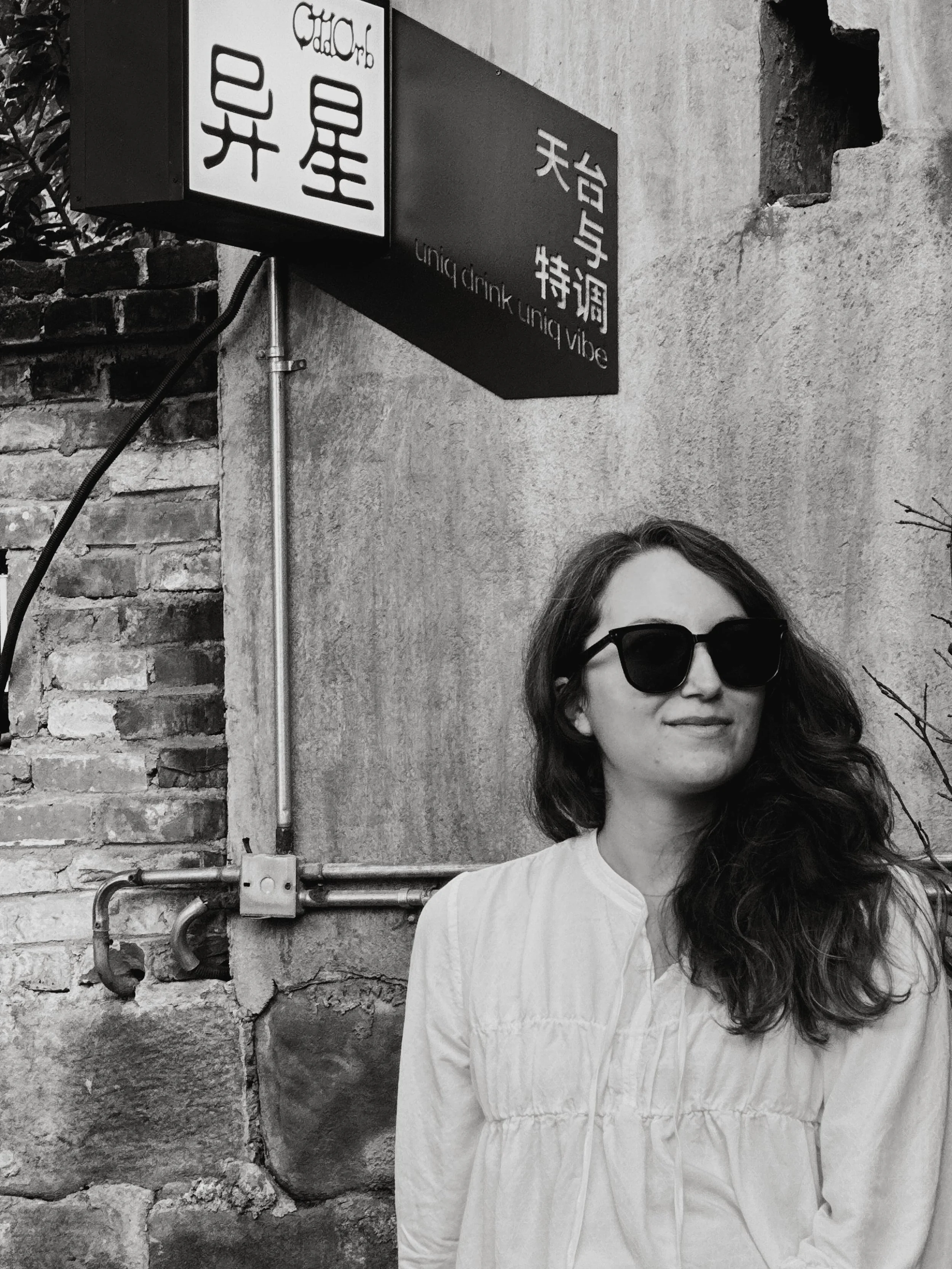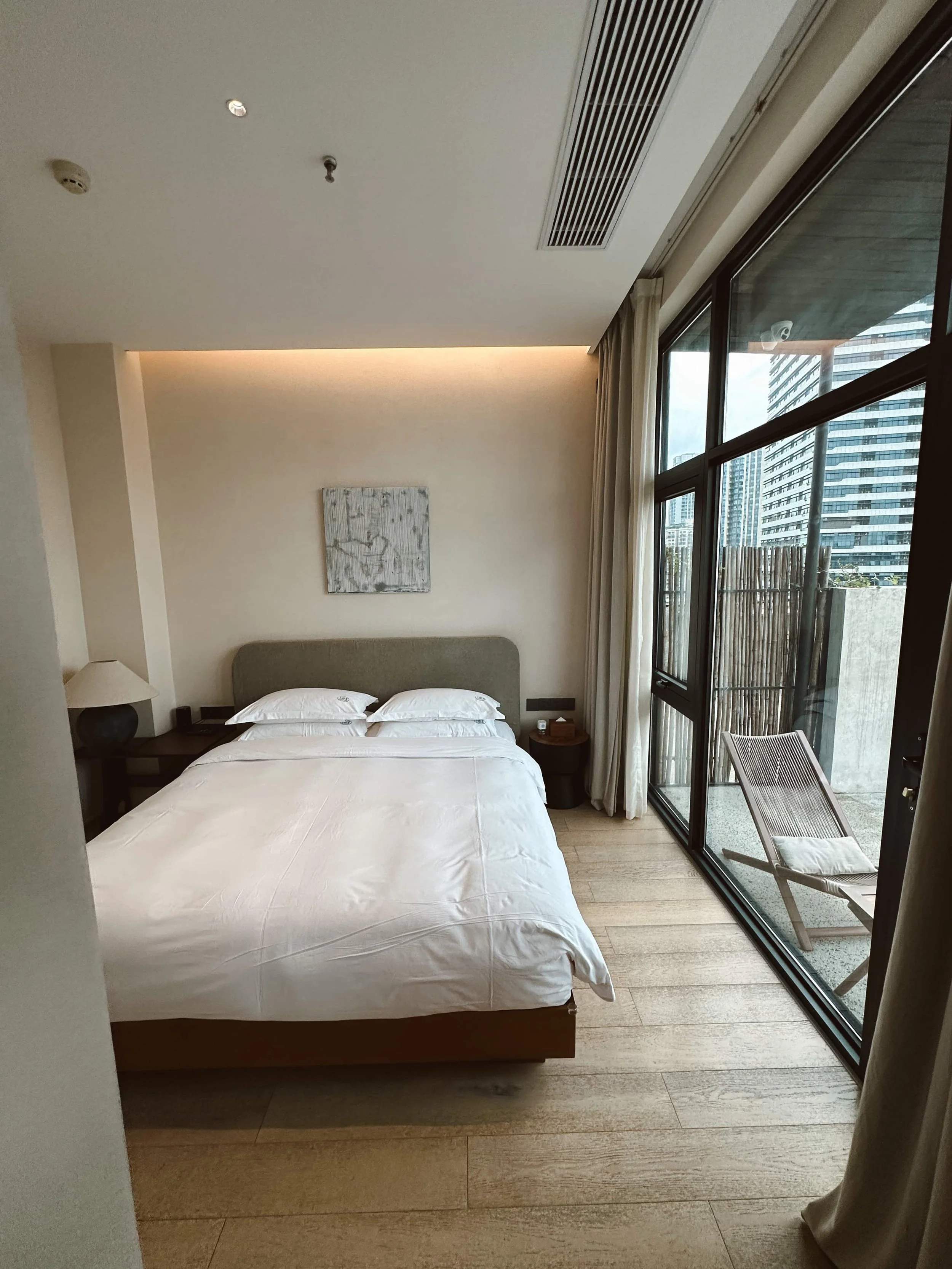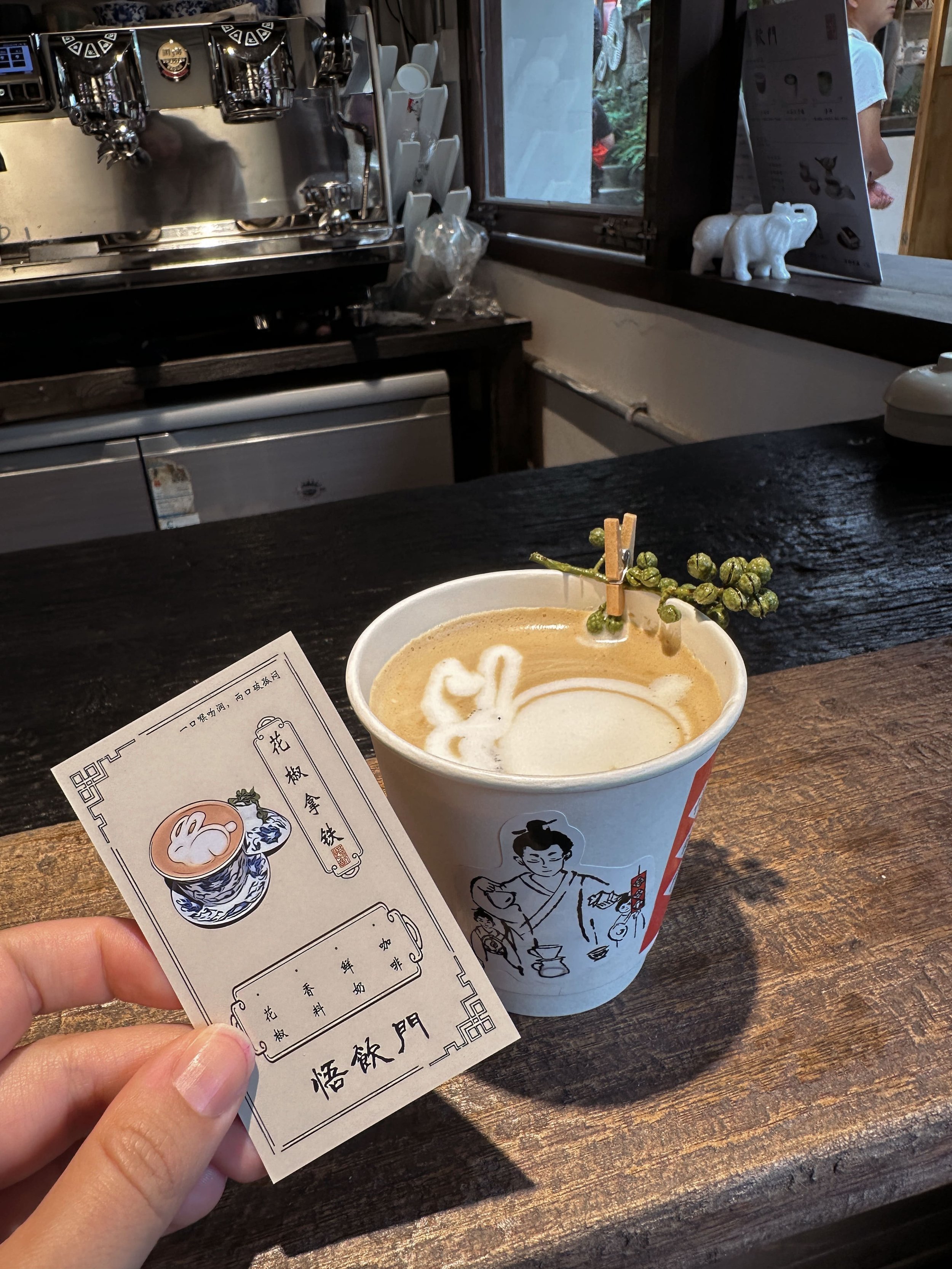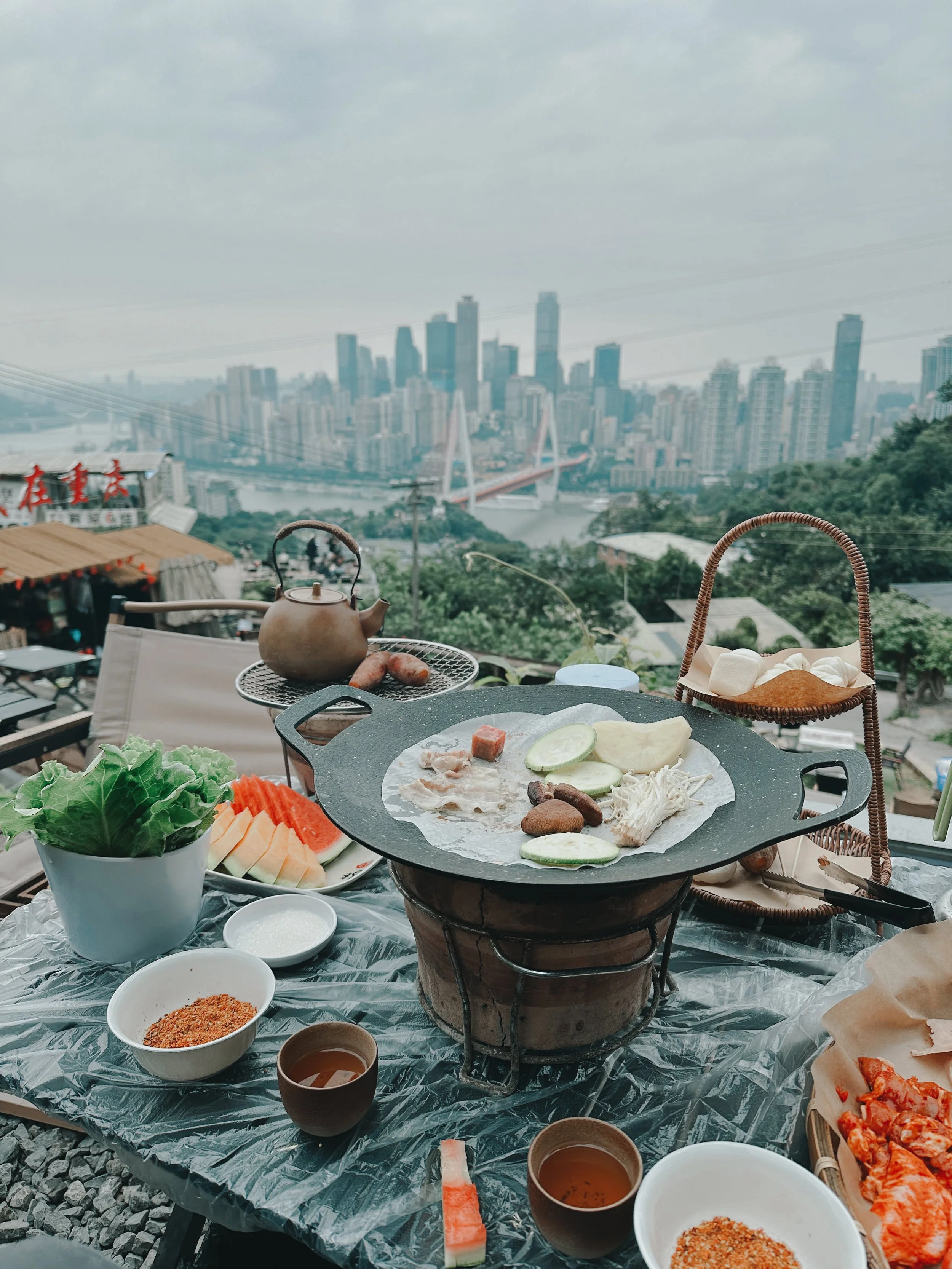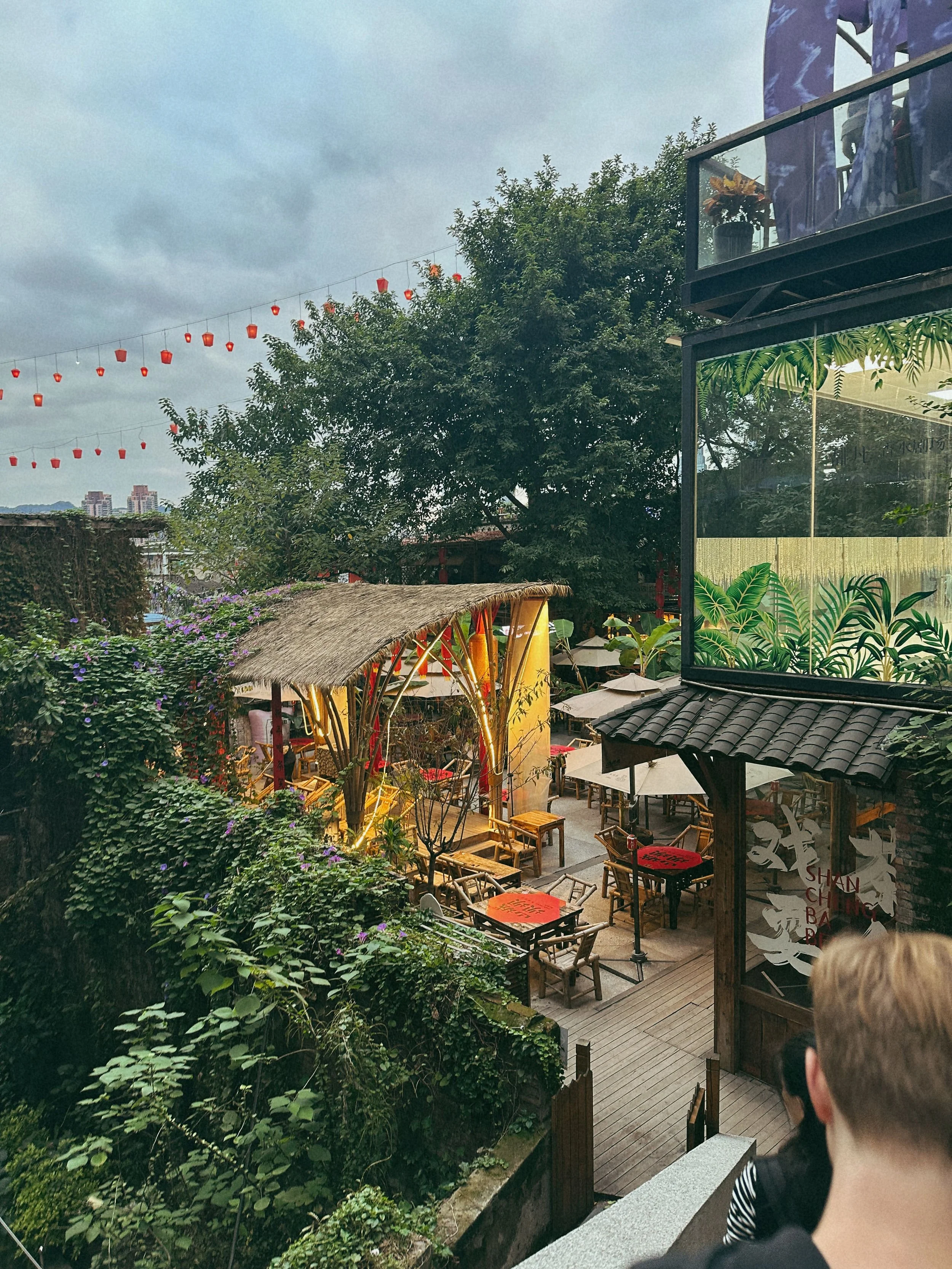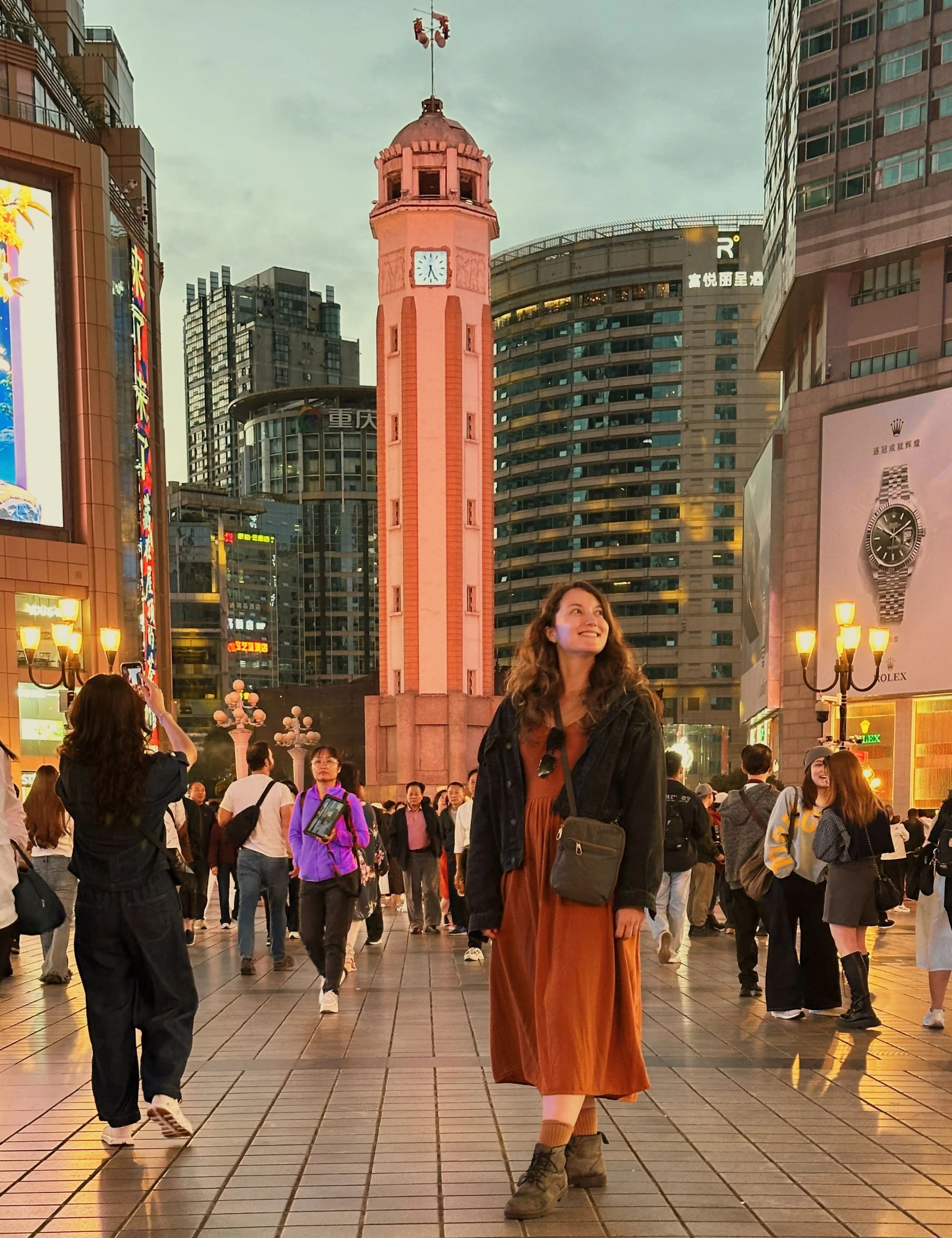Travel Guide: Chongqing, China
Chongqing is not a city — it’s a vertical fever dream.
Built into the misty mountains of Southwest China, this former wartime capital feels like what would happen if Blade Runner collided with a hotpot-fueled fever dream. One minute you’re on “street level,” the next you’re gazing down 30 stories at someone else’s street level. Elevators here aren’t luxuries — they’re survival tools.
Often called China’s “cyberpunk city,” Chongqing is a dizzying blend of brutalist architecture, neon-lit malls, and no-nonsense street markets where butchered ducks swing from hooks beside crates of live ones — all while a bubbling cauldron of Szechuan hotpot threatens to melt your face off (in the best way). It’s chaotic, cinematic, unapologetic. And I loved it.
Kyle described it as “unfussy,” which I think is perfect. This city doesn’t try to impress you. It just is. Raw. Spicy. Beautifully complex. From midnight views of the skyline across the Yangtze to mall escalators that ascend into clouds, Chongqing surprised me at every turn.
It’s the kind of place that makes you grateful for a career that lets you hit pause on your inbox and say yes to adventure — one of the many reasons I started ✍️ Make Writing Your Job, a curated board of high-paying freelance writing work. Freelance writing has helped fund my life as a traveling author, and I’m always trying to help other writers bet on themselves so they can travel the world, too.
If you’re curious about this mountaintop metropolis (and maybe a little spicy tofu), here’s my full guide to one of China’s most unforgettable cities.
Where to Stay in Chongqing, China
If you only take one thing from this blog post, let it be this: stay at the Sommet Hotel.
Perched on the 29th floor of a nondescript building (with other hotels and offices on other floors), this boutique hotel feels like a secret penthouse hideaway in the sky. With 7 all-balcony penthouse rooms and sweeping views of Chongqing’s sprawling skyline, Sommet isn’t just a hotel — it’s a front-row seat to the city’s magic.
Each morning, we’d sip coffee on our private balcony as the fog peeled back from the mountains. Each night, we watched the skyline light up like a motherboard. One night, the staff even texted us when the drone show started. It’s a great place to admire the city without the crowds or chaos.
The rooms? Modern, minimalist, and surprisingly cozy — especially the beds, which were dangerously nap-inducing. The service? Genuinely next-level. They did our laundry every day so we always had fresh clothes to wear, answered our endless questions, and helped us feel at home from the second we arrived.
But what made this stay exceptional wasn’t just what was inside the hotel — it was what surrounded it.
The neighborhood around Sommet is the perfect base for exploring Chongqing. You’re steps from the metro and Bayi Food Street (a top-tier street food haven), surrounded by hip cafes, hole-in-the-wall hotpot joints, and the quiet charm of residential alleyways where families play mahjong.
Some travel blogs suggest staying elsewhere in the city, but honestly? I think we would’ve liked Chongqing a lot less if we’d followed that advice. Sommet put us at the perfect crossroads: tourist-accessible and deeply local — where you can eat handmade noodles one minute and wander into a concept tea bar the next.
Ten out of ten. Would stay again. Would write a whole novel from that balcony.
What to Eat in Chongqing
Chongqing restored my faith in Chinese cuisine.
After a string of underwhelming meals in Shanghai (Beijing really set the bar high), I wasn’t expecting much. But Chongqing? Chongqing delivered. Bold, spicy, full of character — this city doesn’t just serve food, it dares you to keep up.
If you’re vegetarian-ish — like me — and okay with the occasional accidental splash of meat broth or cross-contamination, you’ll eat well here. If you’re a stricter vegetarian, it’s doable, but definitely a bit trickier. That said, the street food culture is so robust and varied that you’ll still have a good shot at discovering some gems.
Here are the culinary highlights from our time in the city — complete with AMap links (since Google Maps is mostly useless here). If the links don’t work, download the AMap app and copy/paste the Chinese name to search.
🍢 Bayi Food Street
This is one of the best street food markets we visited in all of China. It’s loud, chaotic, and absolutely packed — with people, sizzling stalls, and the scent of chili oil in the air.
We tried a dozen dishes here, but the absolute standout was Bridge Tofu — a crispy deep-fried tofu block drenched in numbing chili sauce, served piping hot. I still dream about this tofu. There’s usually a massive line, and it’s located along the outer edge of the market stalls — just follow your nose (and the crowd).
You could easily spend an entire evening here grazing from stall to stall, trying skewers, dumplings, stir-fries, and sugar-dusted desserts. And the best part? Most dishes are just $1–$2 USD.
🥯 Stuffed Bagels + Chagee Tea
Right next to our hotel we found a modern little bagel shop doing inventive takes on the classic — like purple sweet potato stuffed bagels, matcha cream cheese, or savory veggie options.
It’s directly across the street from Chagee, our go-to tea spot. This became our morning ritual: iced jasmine milk tea + warm stuffed bagel, then off to explore. The neighborhood also has great breakfast stalls if you’re looking for something more traditional — think crispy fried dough sticks and fresh soy milk.
🔥 Air Raid Old Hotpot
We didn’t make it here ourselves, but multiple locals and travelers recommended it. It’s built inside a former World War II air raid shelter — part of Chongqing’s rich wartime history — and serves up spicy hotpot in an atmospheric, cave-like setting.
Even if you don’t make it to this exact spot, you can’t come to Chongqing without trying hotpot. It’s the city’s signature dish. There are hole-in-the-wall hotpot joints on nearly every block, and most are fantastic. Just be warned: spicy in Chongqing doesn’t mean “mildly tingly.” It means you may question your life choices. If you’re spice-sensitive, ask for “no spice” or a half-and-half pot.
What to Do in Chongqing, China
Our mountainside sunset grill
Some of our favorite days in Chongqing were completely unplanned — just wandering into crowded streets, following the smell of something delicious, and pointing at a dish we’d never seen before. It’s a city that rewards curiosity. And as a freelance writer, this is what I live for: days where I get paid to follow my tastebuds around the world.
Chongqing isn’t a checklist city — it’s a choose-your-own-adventure labyrinth of neon, noodles, and unexpected mountain views.
Yes, there are a handful of official “attractions.” But our best days didn’t come from TripAdvisor recs or influencer reels. They came from wandering. From following the smell of grilled tofu up a staircase and finding a skyline cafe we had all to ourselves. From chasing weird lattes and accidentally stumbling into ruins.
Here are some highlights (and a few honorable mentions) from our time exploring this vertical wonderland:
🏮 Sunset Grill Cafes on the Cliffside
The most cinematic thing we did in Chongqing, hands down.
High above the city, tucked into the cliffs like something out of a Studio Ghibli sketchbook, there’s a string of lookout cafes where you can sit for hours and watch the city come to life.
We picked one that offered a personal tabletop grill and a teapot for around 200 RMB per person (about $27 USD). Worth every yuan. As the sun dipped behind the jagged skyline, streetlights flickered on like fireflies and the Yangtze shimmered far below. No one rushed us. No one hovered. We grilled sweet potatoes, drank jasmine tea, and chatted with two Singaporeans next to us as the evening unfolded.
🫖 The Floating Tea Café + Trendy Riverfront Alley
This area felt like a scene from a futuristic food anime.
On the far side of the river, there’s a stylish “alley” district lined with cafes and concept shops — one of which featured a miniature river built into your table, where dishes arrived floating toward you on dry ice clouds. I mean. Come on.
I stopped by a nearby café and ordered a Szechuan peppercorn latte — creamy, spicy, numbing, glorious. Kyle was skeptical of the peppercorns. Then he tossed one in his mouth and had to deal with the numbing sensation the whole way down the mountain. This area was full of quirky shops, rooftop nooks, and surprise views of the city slicing through the mountain gaps. A perfect lazy afternoon spot.
⛪️ Mountain City Ruins + Neon Nights
This one was hard to find — and that made it even better.
Built around the decaying bones of a French Catholic church from the colonial era, Mountain City is where ruins and rave lights coexist. Think ivy-covered archways, stone stairs that lead nowhere, and then — surprise! — a bar blaring Mandopop under a string of disco lights.
We only found it through a private guide, and it didn’t show up on any major blogs or guides. But if you can track it down, it’s absolutely worth visiting in the morning for cliffside coffee, or around sunset when the lights come on and the live music kicks off.
🎭 Ciqikou Ancient Town + Chongqing 1949
Located about an hour from the city center, Ciqikou Ancient Town is charming in that slightly tourist-trappy way — paper lanterns, souvenir shops, snacks-on-sticks — but it’s still a fun stroll.
The real reason to come here, though, is Chongqing 1949, a rotating-stage performance-meets-patriotic fever dream that was surprisingly cool. The stage and seats both rotate 360°, and the best views are in the B section. The whole thing lasts around 70 minutes and can be booked easily on Trip.com.
We did the afternoon show, which I recommend — that way you can explore Ciqikou while it’s still light out and be back in the city by dinner.
Honorable Mentions (aka: Nice, but Not Must-Sees)
Hongyadong at Night: Pretty lights, packed crowds for when the lights turn on at around 7pm. Instagrammable but overrated.
Raffles Mall: Visually stunning, but if you’ve seen one luxury mall, you’ve seen them all.
Jieufenbei Pedestrian Street: Great if you want to shop; we mostly just wanted snacks.
The Ring Mall: Supposedly Chongqing’s answer to Singapore’s Jewel — but we skipped it in favor of hotpot and naps.
Hotpot-Themed Spa: Yes, it exists. No, we didn’t go. But it’s still living rent-free in my mind.
Chongqing isn’t about big ticket attractions — it’s about micro-adventures. Ducking down staircases. Ordering spicy drinks you didn’t know existed. Peeking through alleyways and realizing you’re 30 stories up. If you let yourself get a little lost, this city will reward you.
The Best Time of Year to Visit Chongqing, China
End of October in Chongqing is perfection — like the city slipped into something more comfortable just for you.
The air was crisp but not cold, hovering between 60 and 70°F. Light jacket weather. Cloud-filtered sunshine. No sweat, no shivers — just right. The summer heat had finally backed off, the rainy season had wrapped up, and the mosquitos had (mostly) either died off or found new targets. We were able to hike around, sip tea outdoors, and explore open-air markets without melting into the pavement or attracting every insect within a 10-block radius.
Fall in China is definitely the move — and our itinerary accidentally nailed it. We started in Beijing at the beginning of October, right after Golden Week (when the crowds thinned but the leaves were just starting to turn), then drifted south as the weather cooled: Beijing → Shanghai → Chongqing → Shenzhen → Hong Kong. Like birds with VPNs.
Nearly every traveler we met was following a similar southbound migration — dodging heat, humidity, and peak tourism in one elegant swoop. There’s a rhythm to this route, and fall is the sweet spot for hitting all the major cities without sweat stains or sold-out train tickets.
Would I visit Chongqing in the summer? Honestly, no. Unless you love mosquito bites and spicy hotpot-induced heat strokes. But in late October? The city is alive, the air is breathable, and the mountains look especially dramatic under that soft autumn haze.
So yes — come in the fall. Let the city surprise you while the weather behaves.
Overall Impressions of Chongqing, China
As our month-long journey through China winds down, I’ve started thinking of each city as a different chapter in a sprawling novel:
Beijing is the prologue — all dynasties and drum beats, steeped in history and haze.
Shanghai is the polished middle act — a bridge suspended between East and West, tradition and ambition.
Chongqing is the plot twist — an unexpected tangle of mountain stairs, sizzling hotpot, brutalist skyscrapers, and flying drones.
It’s a city where analog and hypermodern coexist without apology. Where the ancient art of boiling meat in chili oil is just as revered as nightly drone shows that paint the sky with pixelated dragons.
I loved waking up in our penthouse suite, sipping coffee brewed by the kind front desk staff, and watching the morning mist peel off the river. That hotel — with its wraparound views and absurdly affordable luxury — was a highlight in itself. It made the city feel less like a destination and more like a reward.
There’s something inherently generous about Chongqing. It doesn’t posture. It just is. One minute you’re walking past hanging laundry and elders playing mahjong — the next you’re in a neon-lit concept shop buying a bagel stuffed with purple yam.
Whatever you’re chasing in China — history, fashion, hotpot, a skyline that looks like it was designed by sci-fi architects on deadline — you’ll find a version of it here.
And maybe that’s what I’ve loved most about this whole trip: the permission it gave me to keep evolving. To keep following my curiosity, even when it took me 23 floors underground or 1,000 steps up.
This life — one where I can drop into a mountain city for a week, write in the mornings, and explore in the afternoons — wasn’t handed to me. I built it one client, one story, one experiment at a time.
And if you’re craving more than just a vacation — if you’re dreaming of a life where writing is the passport — ✍️ Make Writing Your Job is where that journey begins.
Want to Become a Writer and Travel the World?
For the past 5 years, I’ve been able to travel the world and spend my weeks bouncing from spas to banquets to food tours while using my writing to fund my adventures.
Want to become a freelance writer or pitch your personal essays or articles and get paid by publications? Or maybe you want to get paid by a grant, contest, or residency to live somewhere unique and get paid to work on your own creative projects?
Over at ✍️ Make Writing Your Job, we’ve built a writing job board to help you get hired and funded for your writing.
Subscribe now for just $15/month to get our daily (5x/week) writing job board as well as all of our other awesome features, such as…
✍️ The Writing Job Board — updated 5x/week with high-paying freelance and ghostwriting work
⭐ Featured Jobs — exclusive roles from clients who post directly to our board (and often nowhere else)
📬 Pitch List — 2x/week newsletter of fresh pitch calls, open submissions, and editors looking for your ideas
🌍 Grants, Residencies & Contests — 1x/week roundup of opportunities that pay you to write, travel, and create
⚡️ New! Job Hunting Assistant — an AI-powered tool that helps you filter listings and find your next dream client even faster
🧠 ClassStack — live classes + our replay library
💬 Subscriber Chat — our private community where our curators drop fresh jobs, and our writers swap wins and advice daily
📰 GuestStack — our $1/word commissioned essay column (and your chance to get published + paid)
Basically, everything you need to make writing your job. See you inside!
